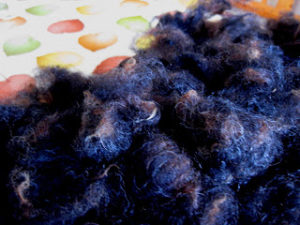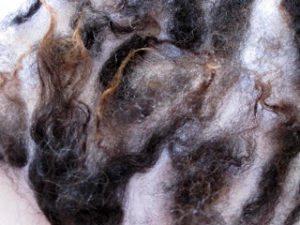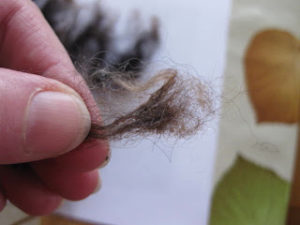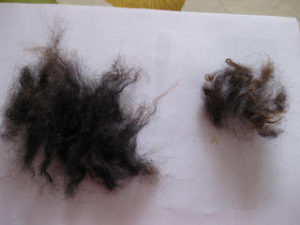English in between
Slutet av året har gått helt i ullens tecken. Vid tiden för eftermiddagskaffet på nyårsafton sorterades den sista fällen av årets höstklippning. Klippningen gjordes sent. Ullen har växt sex månader sedan vårklippningen. Trots regnigt väder både under sommar och höst är ullen superfin.
Vårt senast födda lamm, ett ryalamm, lämnade märgfri, glansig och lång vit ull. Ullen mätte trettio centimeter från klippända till ullens spets.
Jämfört med ull från ett Värmlandslamm är Ryaullen dubbelt så lång.Värmlandsullen har däremot nästan dubbelt så mycket bottenull.
Årets ull var också mycket ren trots att fåren har fått gå in den senaste månaden på grund av det regniga vädret.
Det var bara två av lammen som stått med huvudet under sina mammor när de ätit som jag fick ta bort en del nackull, övrig ull kunde utan urskiljning tas tillvara.
The end of the year has gone completely in the woolly way. At the time of afternoon coffee on New Year’s Eve the final fleece of this year’s autumn shearing was sorted.
The shearing was made late and the wool has grown six months since the spring shearing.
Despite the rainy weather during both the summer and autumn the wool are superfine.Our last-borned lamb, a Rya lamb, left shiny, long white wool free from kemp.The wool measured a foot from the clip end to the tip.Compared to wool from a Värmland lamb the Rya wool is twice as long. The Värmland wool in contrast, has almost twice as much undercoat.
This year’s wool was also very clean despite the fact that the sheep have been allowed to go into the sheep-shed the last month due to the rainy weather.
There were only two of the lambs that stood with their heads under their mothers when they ate that I had to remove some wool from the neck part, other wool was indiscriminately utilized.
| Ull från ett värmlandsfår – Wool from a Wärmland sheep |
| Lammull av Rya tacklamm – Wool from a Rya ewe lamb |
| Brun Värmlandsull och vit Ryaull båda från lamm – Brown wool from a Wärmland ewe lamb and white wool from a Rya ewe lamb |
Nu har vi startat ett nytt får- ullår. Baggarna finns på plats hos tackorna och vi ser fram emot årets lamning – om än mycket senare än tidigare år. Allt för att ge Rutger, vår Klövsjöbagge, möjlighet att växa till sig lite. Rutger har, sedan han kom till oss, varit fixerad vid foderhäcken. Troligtvis hade han inte fått så mycket i sig i konkurrens med övriga bagglamm och baggar på sitt födelsställe. Han har tagit igen det med råge.
Now we have started a new sheep and wool year. The rams are with the ewes and we look forward to this year’s lambing – albeit much later than in previous years. All to give Rutger, our Klövsjö ram, the opportunity to grow up a bit. Rutger has, since he came to us, been fixated into eating. Probably he had not had so much to eat in competition with the other ram lambs and rams at the place where he was borned. He has made up for it by far.
Idag, på det nya årets första arbetsdag, skall jag öppna ett paket med ull från Åland. Jag har tjuvkikat lite innan så jag vet att det är tre fällar av Ålandsfår som kommer från en uppfödare på Åland. Denna uppfödare finns dessutom i samma område som husbon´ns farmorsmor kom ifrån vilket gör det extra roligt att få utforska ullen därifrån. Not Åland tillhörde vid den tiden Sverige.
Ålandsfåret tillhör, precis som både våra Ryafår och Värmlandsfår, de Nordiska kortsvansade fåren, de får som man, trots försök under 1500-1800 talet, inte lyckades utrota till förmån för ”rumpefår” (tyska eller engelska tjock-, långsvansade får). Allmogen motstod alla försök att avla på de får fabrikerna önskade för att kunna framställa kläde och höll fast vid den slitstarka ullen lämplig för vadmal till kläder.
Vad jag hittills kunnat se vid min snabba titt i säcken är att ullen har likheter med Gotlandsull (glans) och Finull (krus). I medskickade prov på fler kvaliteter kan urskiljas ull med både bottenull och täckhår med vågor istället för krus och i de flesta färger.
Att utforska våra grannländers ull från deras inhemska får är en utvidgning av mitt stora ullintresse och skall bli mycket spännande. Här finns det verkligen möjlighet att botanisera utan förutfattade meningar och påverkan från andra och möjlighet att testa olika förberedelser av ull och olika spinnsätt.
Detta är mitt ”nyårslöfte” och referat kommer troligtvis (med all säkerhet) att återkomma ett otal gånger under året som nyss startat..
Today, in the new year’s first day at work, I have opened a package of wool from Åland. I’ve peeked a little before so I know there are three fleeces of Åland sheep, which I got from a breeder in Åland. The farmers also lives in the same area where hubby’s grand-grandmother came from, which makes it extra fun to explore the wool . Note Aland belonged at the time to Sweden.
Åland sheep belong, as both our Ryafår and Värmlandsfår, to the Nordic short-tailed sheep, the sheep that, despite attempts in the 1500-1800 century, failed to eradicate for the benefit of ”rumpefår” (German or English, thick, long-tailed sheep). Peasantry resisted all attempts to breed the sheep to get the wool the mills required to produce cloth and clung to the rugged wool suitable for homespun clothing.
What I have hitherto been able to see in my quick look in the bag, is that the wool is similar to Gotlandsull (gloss) and Finull (crimp). In the pre-supplied sample of more qualities can be distinguished wool with both undercoat and outercoat, wool with waves instead of crimp, and in most colors.
To explore our neighbors wool from their domestic sheep is an extension of my great interest in wool and will be very exciting. There is a real opportunity to explore without bias and the influence of others and the opportunity to test different preparation of wool and various ways to spin.
This is my ”New Year’s resolution” and abstracts will probably (almost certainly) come back numerous times during the year that has just started ..
En God Ullig fortsättning på det Nya Året önskar vi er alla.
A Happy Woolly continuation of the New Year we wish You all



